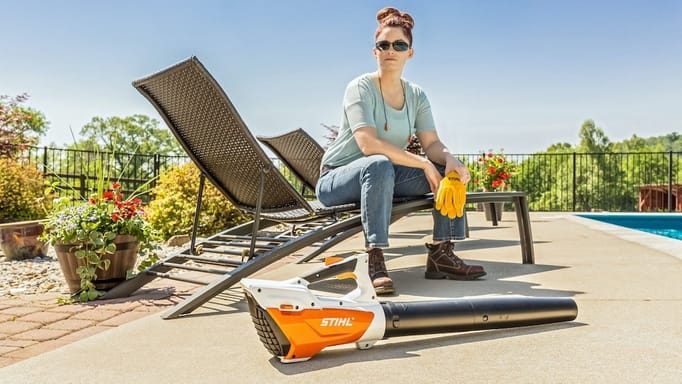
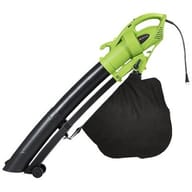
Leaf Vacuum Mulcher Safety Tips - Leaf Mulcher Guide - Leafmulcherhq.com

| ven 25 | sam 26 | dim 27 | lun 28 | mar 29 | mer 30 | jeu 1 |
|---|
Dernier post

Guide to choosing your battery cordless leaf blower
Battery-powered leaf blowers are gaining strength among individuals. Most of them don't need a blower for more than 30 minutes, and the convenience of batteries in a machine makes many people go for them. Here are some guidelines to help you with the choice.
What to look for in the battery of a cordless blower?
We will review the three most important aspects of choosing the battery.
Volts (V)
Volts measure the electrical voltage that has to be supplied to work properly, in this case, a leaf blower.
The number of volts that a blower supports must be the same as that supplied by a battery. The higher the voltage, the more power can be achieved with the machine. This does not mean that you always have to buy the one with the most volts since, as a general rule, the higher the voltage, the larger the battery has to be and the heavier the machine will be.
Volts for leaf blowers typically range from 12V to 40V. At the moment, the most commonly used batteries in blowers are 18V.
⇨ RELATED: https://gamekit.com/post/show/65975646286653351/
Amp Hours (Ah)
The amp hours of a battery are used to assess the amount of electricity that can be stored during charging and returned during discharge. One oh means a battery can supply 1A for one hour.
If we look at the batteries of the blowers, we see the Ampere hours (Ah) they have. The more Ah., the more electric current it will be able to pass from the battery to the blower every hour and the greater the power available to use.
An 18-volt battery can be supplied with 1 Ah up to 12 Ah. For this reason, all the batteries, regardless of the volts they have, can choose the amp hours we want, considering that the more Ah. The heavier the battery.
Why is battery material so important?
Materials capable of storing the greatest amount of energy in the smallest possible space and with the ability to release it most efficiently are constantly being sought. The batteries that best meet these characteristics are the following.
⇨ RELATED: https://safechat.com/post/3038148785593483467
🔋 Lithium Ions (Li-Ion): Virtually all tool brands develop lithium batteries for their machines.
Advantage
✔️ They are the ones that accumulate the most energy
✔️ They are smaller and lighter
✔️ Very little discharge when not in use
✔️ They do not need to be completely discharged to recharge them
✔️ The time of use between charges is greater
drawbacks
❌ The most expensive
❌ To increase their useful life by 50%, they must be recharged when they are between 20% - 80% of their capacity
❌ They can be recharged fewer times than Nickel ones
❌ Longer recharge time than Nickel
blow speed
For a blower to have enough force to lift any leaf, the speed of the air it expels must be between 150 – 300 km/hour.
blower weight
Although it seems logical that the lower the weight, the more comfortable your work, not everyone gives importance, it deserves this parameter.
Luckily, battery-powered blowers usually weigh from 1 to 4 kg without a battery; adding this weight would be carrying 0.5 – 1 kg more, depending on the one we choose. As you can see, the weight is very low, and the handling will be done with ease.
Battery compatibility
Not all brands have the same facility to share batteries or the same number of tools to share them.
Check what tools you have and what tools you may need in the future to try to buy from the same brand.
Battery Leaf Blower Maintenance Guide
The maintenance of a battery blower is very simple; even so, it is essential to give it the care it needs. In this way, we will be able to extend its useful life. Below are general guidelines for maintenance; in any case, you should always consult the manual of each machine.
Daily
Cleaning: Remove specks of dust accumulated on the machine after each use.
Battery: Once we stop using the blower, disconnect the batteries and store the machine without them. The batteries will be charged for the next workday.
Monthly
General review: Check if the nuts and gears are in good condition.
Annually
Battery: Check that they work correctly; otherwise, buy new ones.
⇨ RELATED: https://leafmulcherhq.com/choose-the-best-cordless-leaf-blower/
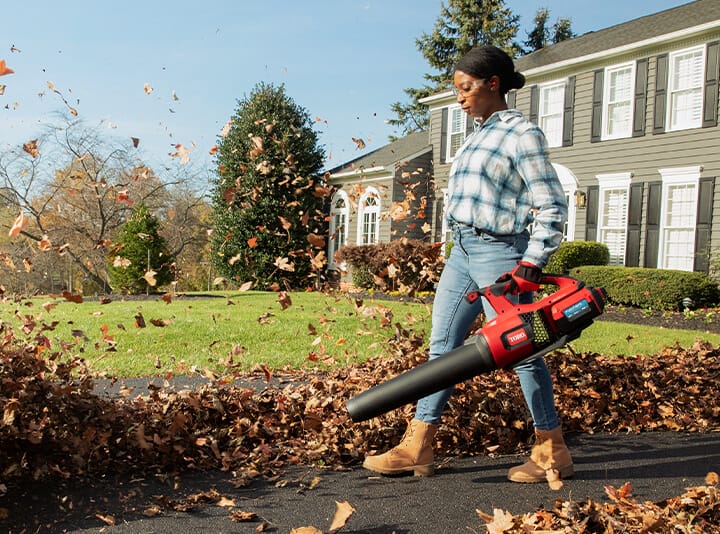

How to Pick the Quietest Leaf Blowers?
Since I know a couple of things about leaf blowers, I got a phone call from a friend who told me “I want a quiet leaf blower, what would you suggest”. This seems like a very simple question but in reality, is not. Let’s see why.
First of all, leaf blowers have mechanical engines, so you can’t say they're quiet. You can at most ask for some quieter than others. In this case, I would have to say that petrol-powered leaf blowers are the noisiest ones (especially older versions), with regular electric powered blowers coming second and battery-powered ones being the quieter. However, the ones quieter are the worst in terms of performance and power. Thus, if the gas blowers can be easily used for any kind of job, cordless ones are more like electric sweepers and can’t even battle with leaves on the lawn.
So, if you’d look for a good quiet leaf blower, you will have to go for a standard electric one, that comes with an attached cord. But you’ll lack mobility. or, as an alternative, there are the new quieter petrol-powered devices for Stihl, but they are not as quiet as they claim they are and are really really expensive: if a standard electric blower costs around $70, a good Stihl would be around $200. And I for one don’t think that’s just worth it.
That’s why I’d recommend sticking with the electrical blowers. Here you can find our best picks of such devices.
Read more:
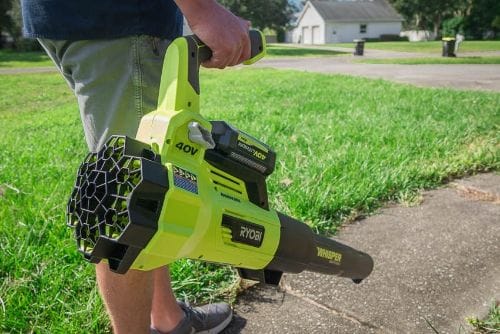
The quietest leaf blower should be exceptionally quiet from a distance of 50 feet. The lower the decibel rating the quieter the blower is

Best Leaf Vacuum Mulcher Buyer's Guide
Autumn: The season of blue skies, foggy mornings, beautiful sunrises, and a bright red glow in the sky as the sun sets at the end of the day. Sound perfect? It's very nearly there, but it's also invisible to your garden lawn, driveway, patio, or border, thanks to the ever-growing carpet of dead leaves!!
Scattered leaves can leave your garden looking messy. Garden cleanup is necessary, but a leaf vacuum is guaranteed to make the job faster and easier.
The best leaf vacuum cleaner is a must-have in your kit. They suck dead leaves; shredding, grinding, and removal can simply be emptied into waste bins in your garden or your compost pile.
It's not a job that any of us particularly enjoy, but removing dead leaves and other garden debris from your lawn is important. If left on, rot problems can limit the amount of sunlight the grass is exposed to, which can affect the health of your lawn and harbor diseases that can be difficult to get rid of once you get rid of them. If you want a healthy green lawn next summer, you must keep your garden clear in the cold months.
best pick leaf vacuum
Bosch ALS2500 electric garden blower and vacuum variables blowing speeds up to 300 km per hour for light sweeping to remove sticky, wet leaves.
2500W motor gives a powerful performance of up to 800 cum per hour volume flow; adjustable handle and padded shoulder strap for comfortable use without shoulder or arm pain
10:1 shredding thanks to long working hours - more compact leaves for composting. Variable airflow speed: 280-300 km/h
Lightweight 3.2kg (blowing function) and 4.4kg (vacuum function) for effortless collection of garden foliage
easy emptying
Read reviews & Amazon's sales ranking is 5909th. Value-added tax (excluding tax)
Last update on2021-12-03|Images from Amazon Product Advertising API|As an amazon associate, I earn from qualifying purchases
Once you have established that foliage in your garden is a problem, you can help yourself.
The main difference between a leaf vacuum cleaner and a leaf blower is that the blower only moves the leaves – leaf removal must be done manually.
Leaf Vacuum effectively "sucks" dead leaves into a removable bag or lightweight box that can simply be emptied into your garden waste bin.
A leaf blower vacuum includes both functions and changes between modes at the touch of a button.
leaf vacuum vs. leaf blower
If you're happy that a single-function leaf vacuum can clear your garden in just one mode, it's great, but if you're still undecided, the leaf vacuum combi mode.
The best leaf vacuum cleaners are the combi models: the 2-in-1 or 3-in-1 models mean the leaves that allow you to switch between blowing, vacuuming, and mulching modes. Not safe as there is a mode for transferring stubborn garden waste.
2-in-1 blower/vacuum combi models tend to have the blow and vac tubes parallel to each other. This is convenient and gives you a better chance of clearing particularly stubborn blockages by changing from vac to blow mode.
With the 3-in-1 model, you can:
Blow your leaves into an organized pile
vacuum on leaves
Fit more leaves into collection bags, before emptying them into bins as garden waste, or manure in your compost pile
Once you've decided on a single/multi-function leaf vacuum, you need to consider the following factors to narrow down your search regarding brand selection. And the right model for you:
I would use my leaf vacuum to clear how big the outdoor area is.
Handheld or backpack – how much weight can you comfortably handle?
Electric, petrol, cordless?
storage space
Desirable additional features
budget
guarantee
There are a lot of brands and models out there that claim to be the best but cheap and lightweight models. The best leaf vacuum cleaners can easily remove waterlogged, dense garden foliage. What you definitely don't want is a useless vacuum that struggles to pick up wet leaves or "leaves" and, given the sweeping brushes and shovels, faster,!! Spending more on leaf vacuums can make your garden easier, faster, and stress-free.
Read more:
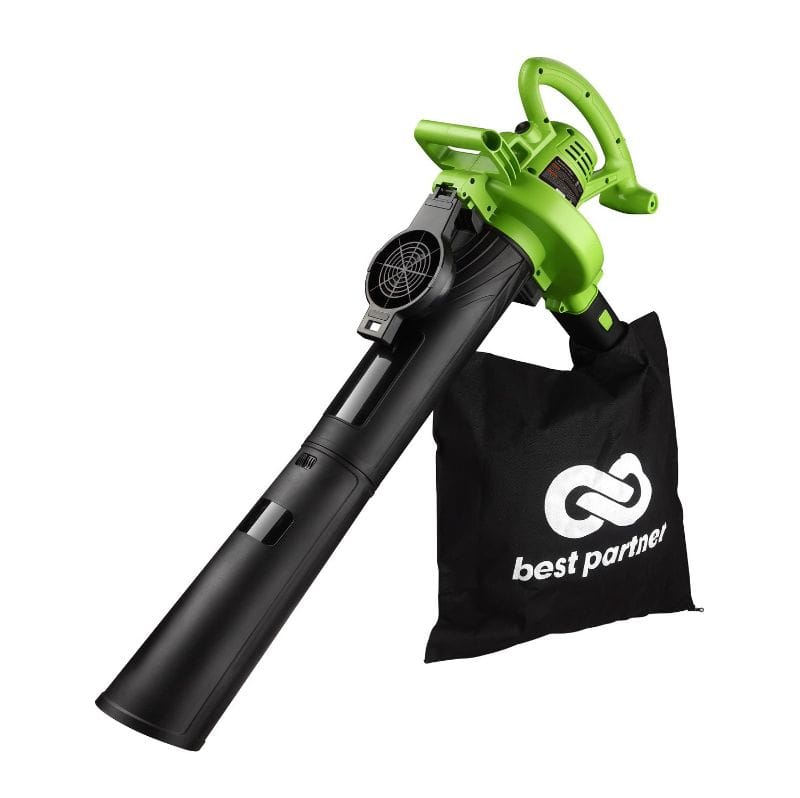
Best Partner Leaf Blower Review and Explain What makes this product become the best leaf vacuum mulcher blower?

When is it worth buying a leaf vacuum mulcher and how to use it?
The variety of colors on the trees heralding the coming winter means that soon we will have more work to do in the garden, on which the rain of leaves will inevitably fall. They used to be dealt with with a rake, but today vacuum mulchers and blowers come to our rescue.
The idea is simple. A device equipped with an electric or combustion engine generates an air rush that, depending on the direction of the draft, can turn into a leaf vacuum mulcher or blower. In the first case, the leaves are sucked through the nozzle into the bag, undergoing additional fragmentation along the way. In the second - a stream of air thrown at great speed blows scattered leaves from the lawn, gathering them in the place we choose.
⇨ RELATED: https://vk.com/leafvacuummulcher
How to use a vacuum mulcher - leaf blower?
It is worth planning cleaning on a sunny day, when the leaves are dry and light, thanks to which they will be easier to succumb to the air stream and will not stick to the nozzle and the bag. When operating the device, try not to hold it too close to the ground so that it does not suck in soil or stones in addition to leaves. With limited visibility, e.g. when cleaning under a spreading bush, it is worth blowing out the leaves from under the branches first and then - after changing the direction of the airflow - sucking them into the bag.
By choosing the suction option, it will be convenient to move around the garden and make swinging movements with the vacuum mulcher - move the inlet to the left and right. It is not like using traditional vacuum mulchers, but the difference is that the NAC leaf blower vacuum mulcher does not have to (and should not) touch the ground during operation.
When blowing leaves, direct them to a common pile, which can then be easily cleaned up. So you can start cleaning from the edges of the garden and work towards the center. After using the device, we should clean it and check that none of the parts have come loose.
⇨ RELATED: https://flipboard.com/@bestleafvacuum
When working in the garden or orchard, let us remember that we are a small part of a huge ecosystem. A true nature lover does not mow the lawn to the ground and remove all the leaves from the wastebasket. The measure of his sense of responsibility for nature is mounds of leaves left in secluded places during the winter, where ... hedgehogs will find a cozy shelter! These lovely defenseless creatures hibernate at temperatures below 10 degrees Celsius, burying themselves in the leaves beforehand. They will repay us for our care in the spring by effectively reducing the population of snails, which are their delicious delicacy.
Electric or petrol leaf blower?
In addition to petrol garden leaf vacuum mulchers, electric models are also available, but these work well only in small yards where the user is always close to the socket. The use of extension cords can be troublesome, while the combustion model is universal: small, handy, easy to use, and effective, and when not in use, it takes up little space in the garage or wardrobe. The advantage of an electric leaf vacuum mulcher, however, is that there is no need to refuel.
⇨ RELATED: https://mastodon.social/@leafmulcherhq
Which leaf blower to choose? The decision should be made after considering what is more important to us: the mobility provided by the lack of a power cord or the convenience of not having to refuel. The power of the equipment is an extremely important factor when choosing a model - the greater it is, the more effective and faster the cleaning will be. The capacity of the leaf bag is also important, especially in the case of larger properties - small bags need to be emptied often.
When to buy a leaf blower? Not necessarily when there are always leaves from trees on the lawn. A leaf vacuum mulcher with a blower is a device with which you can also get rid of mowed grass or sand. The low price makes them worth having in almost every household with a driveway and a garden.


Compare the best leaf blowers.
Having trees in the garden or living in a tree-filled environment is, of course, wonderful. But in the fall, you're just happy with a leaf blower. The leaf blower has become an indispensable tool in many gardens.
Professionally, this handy tool in the fight against leaves has already proved its worth with many gardeners and parks services and is now also gaining a lot of ground in the consumer market. As a result, there is a lot of choice in leaf blowers, and it can be difficult to determine what to look for when purchasing. Do you go purely for the cheapest leaf blower, or do you want an all-rounder?
Our top 10 best leaf blowers give you a good idea of which models excel in price, quality, and possibilities. These models are therefore very popular in sales. With this decision aid, you can make a good, well-considered choice. This way, you will find the ideal leaf blower with which you can make short work of the leaves in your garden in no time. This way, it will look neat all year round.
Different types of leaf blowers and vacuum mulchers
What is the best leaf blower, and what is the best leaf vacuum? As with many garden tools, you have a choice of petrol models in addition to electrical equipment. An electric leaf blower is more environmentally friendly than a model powered by gasoline. It also requires less maintenance, and it is not necessary to buy special fuel (mixing lubrication). You just put the plug in the socket and blow away. Or, if you want more freedom of movement, choose a battery as the power source.
With professional models, you often carry the motor and/or a collection reservoir on your back for extra comfort. But that is especially necessary if you are working for hours on end. In our top 10 best leaf blower comparisons, we only have models that you can fully control.
A petrol model is usually a lot more professional. You can move freely everywhere, and you usually have a motor with a lot of power at your disposal. They are therefore well suited to larger gardens with a lot of fallen leaves. A leaf blower with a power cable is a lot lighter due to the lack of a battery or petrol tank, but the cable also gives you a more limited range. With a battery, you have the freedom of movement of a petrol engine, and it is more environmentally friendly, but with an empty battery, you have to wait until it is charged again.
Blowing force
What can also play a role when choosing a leaf blower is the blowing force. The standard method of indicating the blowing force is the speed at which the air and leaves are blown, i.e., in km/h. The higher it is, the faster and more efficient you can get the garden ready. As a rule of thumb, you can assume that a blowing force of up to 250 km/h is enough for small gardens and/or few leaves. For a medium-sized blowing job, you are fine with a blowing force between 250 and 300 km/h. Larger gardens and/or quantities of leaves require a higher blowing force, preferably above 300 km/h.
Leaf blowers and leaf vacuums: what's the difference?
So far, we've talked about leaf blowers, but if you start looking at the top 10 best leaf blower comparisons, you'll see that many of those models are also capable of vacuuming leaves. The leaf is then neatly collected in a collection container. This is, of course, a much more efficient way to get rid of the leaves in your garden: if you only blow them away, you still have to sweep them up and dispose of them as waste.
Leaf vacuums that also have a shredding function are therefore ideal. As a result, the leaf takes up much less space, and in the end, a lot more will fit in your green container. You can tell from the shredding ratio how much less space the leaves take up.
Read more:
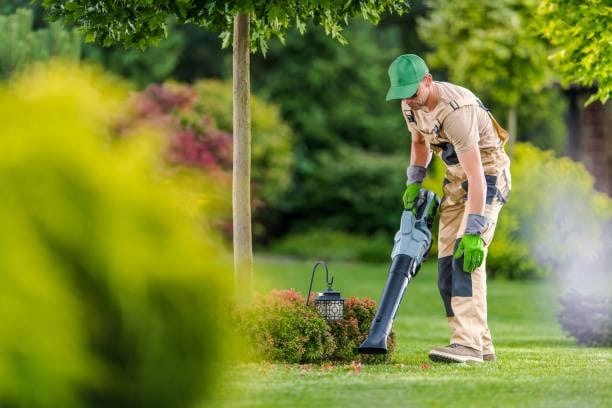
There are four different varieties of leaf blowers like the electric, cordless, gas blower, and backpack models which satisfy the any demands

Leaf Blower – How it works, types, uses, and new trends.
Blowers are one of the best options for removing dirt and keeping green, open, and other areas clear. These tools implement their blowing or suction power to clean a wide variety of surfaces in a practical, effective and fast way.
How does a blower work?
No matter its model, a blower uses centrifugal force to move trash, leaves, or debris into one place for easy collection.
Internally, the blower has a fan with many blades, which takes the air from the outside and makes it rotate, pushing it through the blower tube, which has a small opening. Due to the centrifugal force, the pressure builds up, and the air coming through the tube comes out at a high-speed rate, sometimes reaching 250 mph.
types of blowers
Blowers can be broadly classified into two types, gasoline or electric.
Gasoline blowers: this type of blower is much more powerful; as a counterpart, it generates more noise and gives off a smell of gasoline. The models that have a two-cycle engine need a combination of oil and gasoline as fuel.
This type of blower can be obtained in several models. Among the laptops, we have those that can be carried by hand and those that can be carried as a backpack or backpack. There is another much larger model, which must be pushed by the user, like a lawnmower.
Gasoline blower
Electric blowers: These blowers are less powerful than gasoline blowers, although they are much lighter, generate less noise, and do not give off an odor. Two models are presented, those that work connected to the power outlet and those that work with a battery.
How to use a blower?
Using this handy and powerful tool is easy, whether you're using the small or larger model. Next, we will indicate the steps to follow so that you execute your work in the shortest possible time and with the greatest possible efficiency.
The first step is to set the "Start/Stop" switch to the "Start" option. On most gas blowers, the switch has the options for "Run and Start/Stop."
Next (this only applies to gasoline blowers ), you must locate the small plastic bubble that is near the fuel tank. The button must be pressed 2 or 3 times to create the suction that launches gasoline into the bubble, which will be used when the blower starts.
Subsequently, the blower motor must be started or started, for which the starter rope must only be pulled quickly. This should be done until the motor runs continuously.
The next step is to set the blower switch to the "Run" option. This way, the instrument will start to work constantly and expel air.
To continue, you must keep the blower close to your body and point the axis of the tool at a small angle with the ground; it is important that you walk slowly, moving the blower gently back and forth.
Once the job is done, be sure to set the switch on the blower to the "Stop" option. Store the tool in a dry place.
Always read the tool's manual before starting to use it.
Tips for using the blower
It is advisable that you define the place of garbage collection before starting to use it. A good practice is placing a tarpaulin or mesh on the site to facilitate waste collection.
The work is much more effective if you work in a single direction.
It is recommended to wear eye, ear, and hand protection during use.
It is recommended to use the blower during a dry day; the wet trash or debris adheres to the surfaces making the job more difficult.
Please note that the blower generates noise, which in some cases can disturb the surroundings. Use it at times that generate less inconvenience.
Blower with collection bag
New trends in the field of blowers
Due to the high demand for blowers, new aspects have been considered in the most recent designs to further facilitate the work of the users of these tools.
The blowers have an ergonomic handle that allows a better grip and manipulation of the instrument. The handle is covered in a special material that prevents you from losing your grip on the tool and also fits naturally in your hand.
The models that are not of the rucksack or rucksack type have a strap that allows the blower to be secured to the user's body, providing greater comfort during the execution of the work.
On the other hand, the new models have been designed with a minimum weight, which considerably improves their transport and handling while in use.
Another of the functions incorporated into the blower is the suction function, which in combination with the shredding function, provides a great advantage when removing dirt. As a complement to these functions, the blowers have a waste or debris collection bag, which in some cases has a capacity of 45 liters.
To facilitate the storage of the tool, some models have a special handle, which allows it to be easily hung.
Read more: https://leafmulcherhq.com/different-types-of-leaf-blowers-on-the-market/
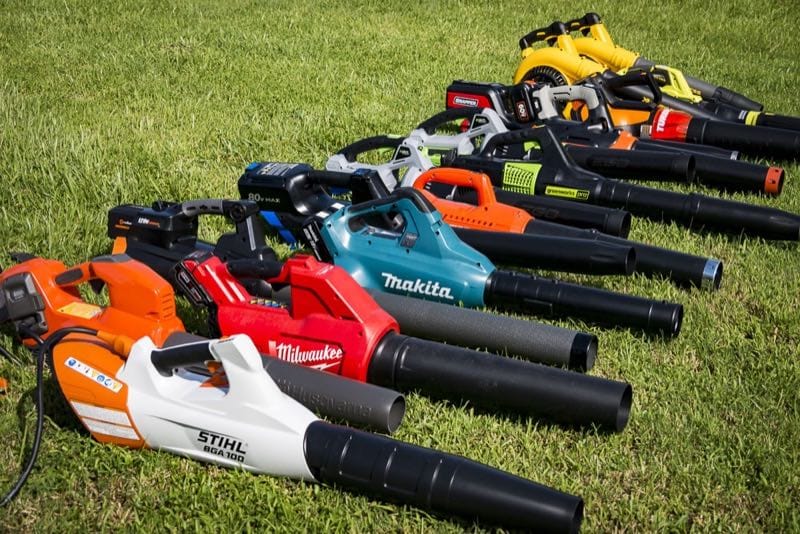
À propos
How do you choose the best leaf blower vacuum mulcher?
A leaf vacuum mulcher is a device that makes our work much more accessible, especially in the fall. How to choose the best one, and what to pay attention to when buying?
Garden vacuum mulchers are primarily used to collect fallen leaves from trees. It is especially useful if you have a large garden with deciduous trees. We can collect leaves in two ways. The first is pulling leaves into a bag mounted on a vacuum mulcher. In addition to leaves, we can also collect small twigs, cones, or grass in this way. Some vacuum mulchers are additionally equipped with grinders that crush the collected plant parts and grind them into smaller pieces. This way, more leaves will fit into the bag and be broken down faster if you use them for compost. The second way is blowing out. If we have a lot of leaves to collect in the garden, I recommend using the blower function. We blow the leaves into one pile and then collect. Sucking such a lot of leaves is impractical because the vacuum mulcher bag has to be emptied every now and then.
Garden vacuum mulchers are also useful in spring and summer. You can clean sidewalks and driveways from residual dust, dirt, and sand by setting the blower function. After scarifying the lawn, vacuum the collected felt with a vacuum mulcher.
What to look for when choosing a vacuum mulcher?
First of all, we need to define our needs. If we have a large plot of land with many deciduous trees, we should choose a powerful petrol vacuum mulcher. It is not powered by electricity, so we do not have to worry that the extension cord will be too short. Electric vacuum mulchers are usually sufficient in smaller home gardens.
Let's pay attention to the power. The bigger, the better. It often happens that devices with too little power do not suck up the twigs and often clog up. The most powerful electric vacuum mulchers have a power of approx. 3000W. A useful function is to regulate the suction power. Remember that the vacuum mulcher should have a blower function. Most are equipped with it, but some only suck.
Let's check which vacuum mulcher has additional accessories. Some are equipped with wheels, thanks to which we can guide the vacuum mulcher on the grass or path. Others have replaceable tips that are mounted on the suction pipe. The tube can be folded, making it easier for us to store the device.
It is also important to make a vacuum mulcher. Let's check if it is properly made and if there are no parts that can easily break or damage. Pay particular attention to the end of the suction pipe. It should be reinforced so that it does not get damaged, e.g., when hitting the pavement. Let's also see how the bag is made. If the material is thin, sucked twigs can tear it apart.
Finally, the most important thing. Libra! Sometimes collecting leaves takes more than an hour, and all this time, we hold the vacuum mulcher in our hand or hang it on our shoulders. Some vacuum mulchers are so heavy that our hands hurt after 15 minutes of work. Remember about the comfort of work and choose the lightest possible vacuum mulchers.
